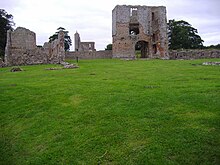Baconsthorpe Castle
Baconsthorpe Castle is the ruins of a fortified mansion in the village of Baconsthorpe in the English county of Norfolk . English Heritage has listed it as a Grade I Historic Building and it is a Scheduled Monument .
history
The Heydons were an ambitious family. They first acquired their fortune as a legal scholar and then in the wool trade. John Heydon came to prominence and influence as a supporter and ally of William de la Pole, 1st Duke of Suffolk . During the turbulent times of the Wars of the Roses (1455–1485), John Heydon often switched sides to his own advantage. Although he managed to amass a large fortune, he made many enemies and was described by his contemporaries as skillful and contentious. His position required a secure base of operations.
construction
This castle was built between 1460 and 1486 by John Heydon and Sir Henry Heydon . Initially, there was no royal permit to fortify it, so the building was just a four-sided mansion that was later fortified. With the family fortune, the house grew and was refined. There was a lake on the east side; the other sides were protected by a deep moat .
Inner gatehouse
A three-story gatehouse was built into the middle of the south wall . It was an imposing symbol of John Heydon's reign, and this gatehouse was also large enough to be defended as an independent residence in times of danger. It had two boxes on the first floor, one for the gatekeeper and the other for the top servant. Upstairs was a spacious suite of sleeping chambers for the Heydon family. There is a description of these rooms in the last will of John Heydon's son, Sir Henry Heydon . They are described as luxuriously furnished with feather beds and silk curtains. The small room directly above the vestibule was intended as a private chapel.
The square
The square was completed with walls, towers and building lines. A building line for the servants stood on the east side of the square. In the Tudor period, John Heydon II had these buildings converted into a wool processing factory. The large windows of this building provided sufficient exposure for spinning and weaving . Many of the towels made in Baconsthorpe were sold in the Netherlands . The coarse fabric was softened by milling . This consisted of pounding the cloth with your feet in soapy water or stale urine . It is thought that this process was carried out in the tower on the northeast corner of the square.
Outer gatehouse
A drawbridge spanned the moat. An outer gatehouse was built 46 meters south. This outer gatehouse was a later addition to the moated residence and was meant to show the family's status and wealth. As part of the outer courtyard, it formed an impressive entrance to Heydon's estate. This courtyard was flanked on the east side by a number of farmhouses. The western flank formed a long barn, parts of which are still used by local farmers today.
The house was disputed in the 16th century when its owner at the time, Sir William Heydon (1540–1594), got into debt and pledged it. In 1590 he decided to sell part of his land, but his son, Sir Christopher Heydon (1561-1623) appealed. Then Sir William threatened the demolition of the house, but Sir Christopher obtained a ban on demolition from the Privy Council and the house was saved. After the English Civil War the house fell into ruin.
Current condition
The ruins are made of flint with a few bricks . The curtain wall is complete and contains the remains of towers. It forms a square enclosure measuring 30 meters by 30 meters. The remains of the three-story gatehouse with the two-story protrusion for the drawbridge lie in the middle of the south wall. The ruins of a two-story building line lie along the east wall.
The ruins are managed by English Heritage and are open to the public.
gallery
Individual evidence
- ↑ OS Explorer Map . Sheet: Norfolk Coast East . Ordnance Survey. ISBN 0-319-21888-0 .
- ↑ a b c Remains of Baconsthorpe Castle . In: The National Heritage List for England . English Heritage. 2011. Accessed November 30, 2015.
- ↑ Baconsthorpe Castle moated site with fortified house, gatehouse, courtyards and formal gardens . In: The National Heritage List for England . English Heritage. 2011. Accessed November 30, 2015.
- ↑ a b c Information board at the castle. English Heritage (4 panels).
- ^ CE Moreton. Oxford Dictionary of National Biography . Entry: Heydon, Sir Henry (d. 1504) . Oxford University Press, Oxford 2004. Retrieved November 30, 2015.
- ↑ Planatgenet Somerset Fry: The David & Charles Book of Castles . David & Charles, Newton Abbot 1980. ISBN 0-7153-7976-3 . P. 181.
- ^ Nikolaus Pevsner, Bill Wilson: Norfolk 1: Norwich and North-East . Chapter: Baconsthorpe . ISBN 0-300-09607-0 .
- ^ Bernard Capp: Oxford Dictionary of National Biography . Entry: Heydon, Sir Christopher . Oxford University Press, Oxford 2004. Retrieved November 30, 2015.
Web links
Coordinates: 52 ° 53 '54.6 " N , 1 ° 9' 7.2" E








